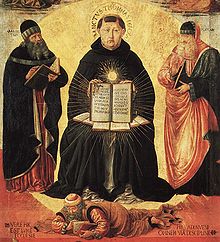Sacramental matter and form
| Part of a series on |
| Thomas Aquinas |
|---|
 |
|
According to St. Thomas Aquinas, the Sacraments of the Church may be described in terms of their matter and form. This concept holds importance not only in the Catholic Church, but also in the Lutheran, Methodist, Eastern Orthodox, Oriental Orthodox, Moravian, and Reformed traditions.
History[]
The idea seems to have been first proposed by William of Auxerre. Thus, for example, the matter for the Sacrament of Baptism is water; the matter for the Sacrament of the Holy Eucharist is bread and wine. The form of a Sacrament consists of the words by which the Sacrament is effected. Thus Saint Thomas Aquinas held that the form of the Sacrament of Penance was "I absolve thee."
The Catechism of the Council of Trent states it this way: "Every Sacrament consists of two things, matter, which is called the element, and form, which is commonly called the word."
Matter and form[]
The term "matter" should be taken broadly to mean that which underlies the Sacrament in a manner similar that the way in which matter underlies substance. Thus the three acts of the penitent are taken to be the matter of Penance: repenting of one's sins, confessing them in words, and intending to do the penance assigned.
Secondly the form of a Sacrament may take significantly different forms in the different rites of the Church. Thus, for example, though Saint Thomas held the form of the Sacrament of Confirmation to be "I sign thee with the sign of the cross...", the Byzantine Rite uses the form "The sign of the seal of the Holy Spirit."
See also[]
References[]
External links[]
- Herbermann, Charles, ed. (1913). . Catholic Encyclopedia. New York: Robert Appleton Company.
- Herbermann, Charles, ed. (1913). . Catholic Encyclopedia. New York: Robert Appleton Company.
- Herbermann, Charles, ed. (1913). . Catholic Encyclopedia. New York: Robert Appleton Company.
- The Catechism of Trent: The Sacraments -- Introduction
- Sacramental theology
- Thomism